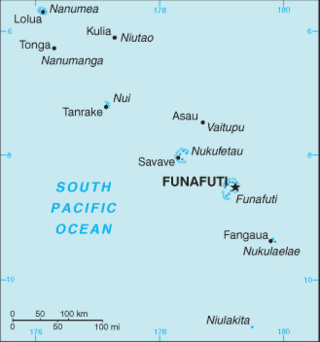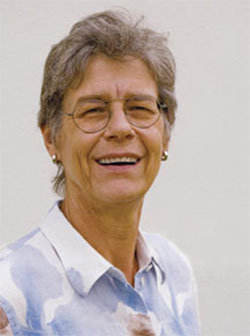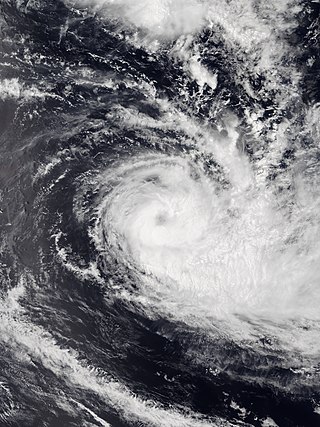Related Research Articles

Tonga, officially the Kingdom of Tonga, is an island country in Polynesia, part of Oceania. The country has 171 islands – of which 45 are inhabited. Its total surface area is about 750 km2 (290 sq mi), scattered over 700,000 km2 (270,000 sq mi) in the southern Pacific Ocean. As of 2021, according to Johnson's Tribune, Tonga has a population of 104,494, 70% of whom reside on the main island, Tongatapu. The country stretches approximately 800 km (500 mi) north-south. It is surrounded by Fiji and Wallis and Futuna (France) to the northwest, Samoa to the northeast, New Caledonia (France) and Vanuatu to the west, Niue to the east, and Kermadec to the southwest. Tonga is about 1,800 km (1,100 mi) from New Zealand's North Island. Tonga is a member of The Commonwealth.

The Western Pacific nation of Tuvalu, formerly known as the Ellice Islands, is situated 4,000 kilometers (2,500 mi) northeast of Australia and is approximately halfway between Hawaii and Australia. It lies east-northeast of the Santa Cruz Islands, southeast of Nauru, south of Kiribati, west of Tokelau, northwest of Samoa and Wallis and Futuna and north of Fiji. It is a very small island country of 26 km2 (10 sq mi). Due to the spread out islands it has the 38th largest Exclusive Economic Zone of 749,790 km2 (289,500 sq mi).

Fishery can mean either the enterprise of raising or harvesting fish and other aquatic life or, more commonly, the site where such enterprise takes place. Commercial fisheries include wild fisheries and fish farms, both in freshwater waterbodies and the oceans. About 500 million people worldwide are economically dependent on fisheries. 171 million tonnes of fish were produced in 2016, but overfishing is an increasing problem, causing declines in some populations.

Tonga, by a modification of its treaty of friendship with the United Kingdom in July 1970, is responsible for its own external affairs. It maintains cordial relations with most countries and has close relations with its Pacific neighbours and the United Kingdom. In 1998, it recognized the People's Republic of China and broke relations with Taiwan.
The Pacific Islands Applied Geoscience Commission (SOPAC) was an inter-governmental regional organisation dedicated to providing services to promote sustainable development in the countries it serves. In 2010, its functions had been transferred to the Pacific Community (SPC) and the Pacific Regional Environment Programme (SPREP), thus ending SOPAC as a separate entity. Today, SOPAC is a division of the SPC with its main office in Suva, Fiji.

Fongafale is the largest of Funafuti's islets in Tuvalu. It is a long narrow sliver of land, 12 kilometres long and between 10 and 400 metres wide, with the South Pacific Ocean and reef on the east and the protected lagoon on the west. The north part is the Tengako peninsula, and Funafuti International Airport runs from northeast to southwest on the widest part of the island, with the village and administrative centre of Vaiaku on the lagoon side.

Environmental resource management is the management of the interaction and impact of human societies on the environment. It is not, as the phrase might suggest, the management of the environment itself. Environmental resources management aims to ensure that ecosystem services are protected and maintained for future human generations, and also maintain ecosystem integrity through considering ethical, economic, and scientific (ecological) variables. Environmental resource management tries to identify factors affected by conflicts that rise between meeting needs and protecting resources. It is thus linked to environmental protection, sustainability, integrated landscape management, natural resource management, fisheries management, forest management, and wildlife management, and others.

Climate change has been a critical issue in Australia since the beginning of the 21st century. Australia is becoming hotter and more prone to extreme heat, bushfires, droughts, floods, and longer fire seasons because of climate change. Climate issues include wildfires, heatwaves, cyclones, rising sea levels, and erosion.
The Environmental Vulnerability Index (EVI) is a measurement devised by the South Pacific Applied Geoscience Commission (SOPAC), the United Nations Environment Program and others to characterize the relative severity of various types of environmental issues suffered by 243 enumerated individual nations and other geographies. The results of the EVI are used to focus on planned solutions to negative pressures on the environment, whilst promoting sustainability.

Severe Tropical Cyclone Kina was at the time the costliest storm to impact Fiji on record. Total losses from Kina are estimated to be near $F170 million ($US110 million). The system was first noted as a tropical depression, to the east of the Solomon Islands on 23 December. Over the next few days the system moved south-eastwards and gradually developed further, before it was named Kina, after it had developed into a tropical cyclone on 26 December.

Severe Tropical Cyclone Sina was the only named tropical cyclone to develop within the South Pacific basin during the 1990–91 season. The system was first noted as a shallow depression within the South Pacific Convergence Zone to the west of Wallis Island. Over the next three days the system moved towards the west-northwest, before it was named Sina during November 24, after it had developed into a tropical cyclone. Over the next couple of days the system intensified further and developed an eye feature as it erratically moved towards Fiji. Sina subsequently peaked in intensity during November 26, before the system passed through the Fijian Islands over the next two days as it started to gradually weaken. Sina subsequently passed just to the north of Tongatapu in Tonga during November 29, before it passed about 160 km (100 mi) to the south of Niue and near the Southern Cook Islands during the next day. The system subsequently rapidly weakened and became an extratropical cyclone during December 1, before they were absorbed by an advancing trough of low pressure near 50°S on December 4.

Severe Tropical Cyclone Hina in March 1997 was the worst tropical cyclone to affect the South Pacific island nation of Tonga since Cyclone Isaac in 1982. The system was first noted within the monsoon trough on March 11, 1997, as a weak shallow depression within the vicinity of Rotuma. Over the next two days, the depression remained near Rotuma with no preferred movement, as it started to develop further within favorable conditions for further development. The system was subsequently named Hina on March 15, after it had started to move eastwards and had passed to the southeast of Niulakita, Tuvalu. During that day the system moved south-eastwards and impacted Wallis and Futuna, before it passed over Tonga's southern islands of Tongatapu and 'Eua during March 16. After impacting Tonga the system moved rapidly towards the south-southeast and weakened below tropical cyclone intensity, before it was last noted on March 21 about 1,500 km (930 mi) to the south of the Pitcairn Islands. During the system's post-analysis, it was determined that the warning centers had underestimated Hina's intensity as it passed over Tonga, after damage in the island nation had been greater than expected.

The Tuvalu Meteorological Service (TMS) is the principal meteorological observatory of Tuvalu and is responsible for providing weather services to the islands of Tuvalu. A meteorological office was established on Funafuti at the time the islands of Tuvalu were administered as parts of the Gilbert and Ellice Islands colony of the United Kingdom. The meteorological office is now an agency of the government of Tuvalu.

The contributions of women in climate change have received increasing attention in the early 21st century. Feedback from women and the issues faced by women have been described as "imperative" by the United Nations and "critical" by the Population Reference Bureau. A report by the World Health Organization concluded that incorporating gender-based analysis would "provide more effective climate change mitigation and adaptation."

The effects of climate change on small island countries are impacting people who live in coastal areas through sea level rise, increasing heavy rain events, tropical cyclones and storm surges. The effects of climate change threaten the existence of many island countries, island peoples and their cultures, and will alter their ecosystems and natural environments. Despite their heterogeneity, small island developing states (SIDS) are recognized as being particularly at risk to climate change. They share numerous common traits and have been quite vocal in calling attention to the challenges they face from climate change.

Margaret A. Davidson was a coastal management pioneer. She spent most of her career working within the National Oceanic and Atmospheric Administration (NOAA), taking leadership roles that drew from her expertise in climate adaptation, sustainable coastal development, and mitigating risk associated with extreme weather events. Among these roles, Davidson served as senior leader on coastal inundation and resilience for NOAA. She is remembered as a "visionary" in coastal science and management, especially for her capacity to engage communities and consider local social and economic issues while making coastal management decisions.

Opha Pauline Dube or Pauline Dube is a Botswanan environmental scientist and Associate Professor in the Department of Environmental Science at the University of Botswana. She co-authored the IPCC's Special Report on Global Warming of 1.5 °C. She is one of fifteen scientists creating the 2023 Global Sustainable Development Report for the United Nations.

Tropical Cyclone Sarai was a moderately strong tropical cyclone that impacted several island nations and countries in late-December 2019. The third tropical cyclone and the second named storm of the 2019-20 South Pacific cyclone season, Sarai formed from an area of low pressure to the south of Tuvalu. Over the next days, the low pressure became organized and was designated by the Fiji Meteorological Service as Tropical Disturbance 03F on December 23. Under favorable conditions, the disturbance gradually organized, becoming a depression two days later, before strengthening to a tropical cyclone, earning the name Sarai. It moved to the south, before a high-pressure steered the system to the east, passing to the south of Fiji, near Suva before weakening. Sarai passed near the Tongan islands of Haʻapai and Tongatapu as a Category 1 cyclone, before rapidly degrading to a tropical depression due to the system entering unfavorable conditions. It was last noted on January 2 to the southeast of Cook Islands.
Cristelle Pratt, a Fijian national, is Assistant Secretary-General for the Environment and Climate Action at the Organisation of African, Caribbean and Pacific States (OACPS), based in Brussels. She is a former Deputy Secretary General of the Pacific Islands Forum (PIF).
References
- ↑ "Dr Netatua Pelesikoti Taufatofua dies suddenly in Tonga". Matangitonga. 2020-11-13. Retrieved 2022-06-18.
- 1 2 3 4 "Netatua Pelesikoti". Pacific Community. 2017-08-19. Retrieved 2018-03-10.
- 1 2 3 4 "Dr Netatua Pelesikoti Taufatofua dies suddenly in Tonga". Matangitonga. 2020-11-13. Retrieved 2020-11-13.
- 1 2 3 4 Shaw, Carole (2020-11-11). "In Memorium – Dr Netatua Prescott Taufatofua". NGO Womens Rights and Gender Equality Caucus - Australia. Retrieved 2021-06-06.
- ↑ Leewai, Kathleen. "Pacific women in climate change - meet Dr Netatua Pelesikoti, Tonga | Climate Change". www.sprep.org. Retrieved 2018-03-10.
- ↑ "Netatua Pelesikoti". The Pacific Community. 2018-12-01. Archived from the original on 1 December 2018.